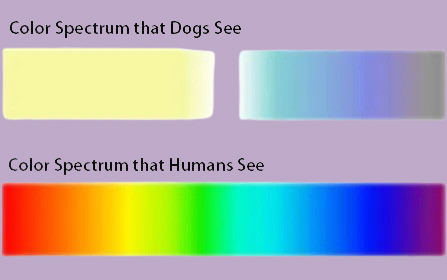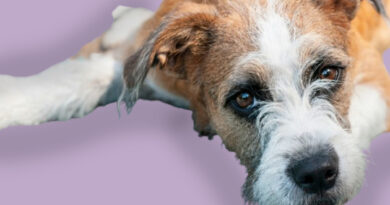What Colors Can Dogs See Best: Exploring the Color Palette of a Dog’s World (2024)
Have you ever wondered What Colors Can Dogs See Best? While humans perceive a vast array of colors, dogs experience the world in a more limited spectrum. Understanding how dogs perceive colors can provide insights into their behavior, preferences, and overall well-being.
Dogs, like humans, have color vision, but their perception differs significantly. While humans have three types of color receptors (cones) in their eyes, allowing us to see a wide range of colors, dogs have only two types of cones. This means they have what is known as dichromatic vision, as opposed to our trichromatic vision.
So, what colors can dogs see best with their dichromatic vision?
Understanding Canine Color Perception:
To comprehend what colors are most visible to dogs, we must first understand their color vision. Dogs primarily perceive the world in shades of blue and yellow, with limited ability to distinguish between red and green hues. This is due to their two types of color receptors, which are most sensitive to blue and yellow wavelengths.
Blue and Yellow Dominance:
Given their heightened sensitivity to blue and yellow, dogs can easily differentiate between various shades within these colors. Shades of blue appear more vivid to them, while yellow stands out prominently against other hues. This preference for blue and yellow can influence their perception of their surroundings, affecting their responses to different objects and environments.
Limited Red and Green Perception:
Unlike humans, who perceive red and green as distinct colors, dogs struggle to differentiate between these hues. Reds and greens appear as variations of yellow to dogs, lacking the vibrancy and richness that humans perceive. Consequently, objects that are red or green may appear dull or indistinguishable to our canine companions.

Implications for Dog Behavior and Training:
Understanding how dogs perceive colors can have practical implications for dog owners, trainers, and caregivers. For instance, when choosing toys or accessories for your dog, opting for shades of blue and yellow can make them more visually appealing and engaging. Additionally, incorporating color cues into training sessions can enhance communication and comprehension for your furry friend.
Environmental Considerations:
The color palette of a dog’s world also influences their perception of the environment. For example, grass and foliage, which appear green to humans, may appear less distinct to dogs due to their limited ability to perceive green hues. Similarly, objects that blend into the background for humans may stand out more prominently to dogs if they contain shades of blue or yellow.
Medical Implications:
Understanding canine color vision is also crucial in the field of veterinary medicine. Certain medical conditions, such as progressive retinal atrophy (PRA), can affect a dog’s vision, including their ability to perceive colors. By recognizing changes in color perception, veterinarians can diagnose and manage these conditions more effectively, ensuring the well-being of their patients.
The Evolutionary Perspective:
Why do dogs have dichromatic vision, while humans have trichromatic vision? The answer lies in evolutionary adaptations shaped by each species’ ecological niche. Dogs, as descendants of wolves, evolved dichromatic vision to better detect movement and distinguish objects in dim lighting conditions, characteristics essential for hunting and survival in their natural habitat.
Color Cues in Training
Color cues can also play a significant role in dog training. While dogs rely heavily on other senses, such as smell and hearing, visual cues can aid in communication and reinforcement during training sessions. For example, using colored markers or flags to indicate specific behaviors or locations can help dogs understand commands more clearly. Additionally, incorporating color-coded obstacles or targets in agility training can enhance dogs’ ability to navigate courses effectively.
Adapting to Dogs’ Color Vision:
Understanding the limitations of dogs’ color vision can help humans adapt their interactions with their canine companions accordingly. For instance, when selecting outdoor gear for activities such as hiking or camping with your dog, opting for contrasting colors that stand out against natural surroundings can make it easier for your dog to spot you from a distance. Similarly, when designing dog-friendly spaces in your home or yard, choosing colors that are visible and appealing to dogs can create a more comfortable and stimulating environment for them.
Visual Impairments and Color Perception:
While most dogs have normal color vision, certain breeds may be more prone to color vision deficiencies or visual impairments. For example, breeds with a high prevalence of inherited eye conditions, such as the Siberian Husky or the Australian Shepherd, may experience changes in color perception as they age. Regular eye examinations by a veterinarian can help detect any vision problems early on, allowing for timely intervention and management.
Colorful Enrichment Activities:
Incorporating colorful enrichment activities into a dog’s daily routine can provide mental stimulation and prevent boredom. Simple DIY activities, such as hiding treats in brightly colored containers or creating a scavenger hunt with colorful objects, can engage a dog’s senses and encourage problem-solving skills. Additionally, interactive toys with vibrant colors and contrasting textures can provide hours of entertainment for dogs, keeping them mentally engaged and physically active.
Educating Pet Owners:
Educating pet owners about dogs’ color vision can foster a deeper understanding of their pets’ needs and preferences. By sharing information about how dogs perceive colors and providing practical tips for enhancing their visual environment, veterinarians, trainers, and animal behaviorists can empower pet owners to enrich their dogs’ lives and strengthen the human-animal bond.

Conclusion
While dogs may not perceive the world in the same kaleidoscope of colors as humans, their unique vision offers a fascinating glimpse into their sensory experience. By understanding the colors that dogs see best, we can enrich their lives, enhance communication, and deepen our bond with our canine companions. So, the next time you play fetch with your furry friend, consider tossing a vibrant blue or yellow toy their way and marvel at the world through their eyes.
FAQ’S (Frequently Asked Questions)
What is the easiest color for dogs to see?
The easiest color for dogs to see is blue, followed by yellow, as they have dichromatic vision, primarily perceiving shades within these hues.
What 3 colors can dogs see?
Dogs can see shades of blue, yellow, and variations within these colors more prominently than others.
What color is most attractive to dogs?
Yellow is often considered the most attractive color to dogs due to their heightened sensitivity to it.
What colors are most appealing to dogs?
Blue and yellow are the most appealing colors to dogs, as they perceive them more vividly than other hues.
What two colors can dogs not see?
Dogs cannot see red and green as distinct colors; they perceive them as variations of yellow due to their limited color receptors.
Can my dog sense my sadness?
Yes, dogs can sense their owners’ sadness through cues such as body language, tone of voice, and scent.
What color is grass to dogs?
Grass appears as shades of yellow to dogs due to their limited ability to perceive green hues.
Can dogs see TV?
Dogs can see TV screens, but their perception may differ from humans, and they may not understand the content in the same way.
What color do dogs not see?
Dogs struggle to distinguish between red and green and perceive them as variations of yellow.
How do dogs see humans faces?
Dogs rely on other cues such as body language, scent, and vocalizations rather than focusing solely on facial features when interacting with humans.
What color light is calming to dogs?
Soft, calming lights such as muted blues or greens can have a soothing effect on dogs.
What can dogs see that humans can t?
Dogs have superior low-light vision compared to humans, allowing them to see in dimmer environments more effectively.




